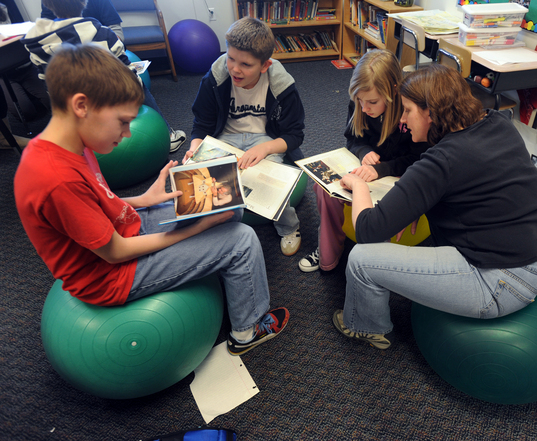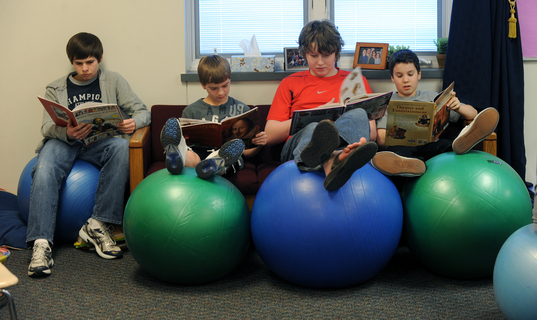Ann Arbor Christian School finds yoga balls help students learn

Lon Horwedel | AnnArbor.com
Janet Jansen's 7th grade classroom at Ann Arbor Christian School looks more like an exercise class than a schoolroom.
Most students are sitting on yoga balls instead of chairs, and balancing, bouncing, or rocking. When asked to get into study groups, they simply roll over to their peers.
But they are definitely learning. They're studying the Northern European Renaissance and Shakespeare and their brains are mopping up every little detail.
Jansen decided to try the exercise balls in her classroom after taking a brain-research class last fall. She found out that most kids learn better in a dynamic environment that uses sensory input.
The yoga balls provide cross-lateral movement as the kids' bodies makes small adjustments to stay balanced on the balls. These small movements engage both sides of the brain, which makes their memories work better and helps them to stay focused.
"When you’re on a yoga ball you engage this nerve ending that is in your quads and bumps up into your brain," Jansen said. "Middle school kids have a very hard time with their sleep schedules and the first three hours of school are especially hard, when they are still trying to wake up. Suddenly, the kids were more awake, more attentive. It just really transformed the classroom environment."
"We started off with two balls and the kids absolutely loved it. We noticed immediately that the kids, especially the ones who were kinesthetic learners, were way more attentive and way more engaged."
The kids agree.
"You don't get bored and they help you to focus more," said Ben Robson, a seventh-grade student. "They definitely make school more fun."
"When your done with something you can bounce or wiggle around instead of just sit there," said Tim Armbruster.

Ann Arbor Christian School seventh-graders, from left, Jonathan Kandelmeyer, Tim Armbruster, Jake Blomberg, and Ben Robson, use exercise balls as chairs and foot stools as they study Shakespeare.
Lon Horwedel | AnnArbor.com
The balls seem to eliminate fidgeting in chairs, clicking pencils, and other restlessness that kids often demonstrate. Also, instead of drifting off and staring around the classroom, students seem more tuned in.
"They make you fidget less with your hands," said Joel Anderson.
There are several benefits to the exercise balls besides enhanced learning. Aside from giving the kids the freedom to move around or "squirm" in their seat, the balls force you to sit in an upright posture, and the balancing required to stay on the ball builds core muscle strength.
Greg Yoder, a teacher consultant from Christian Learning Center in Grand Rapids encouraged Jansen to do more. Yoder partners with Ann Arbor Christian School regularly to address special needs of the students and enhance learning. He suggested that the more dynamic an environment was, the more conducive to learning.
Since nearly everybody wanted a yoga ball, the middle school grammar group wrote letters to four retailers asking for donations. So far Meijer and Dicks Sporting Goods have donated eight balls, and now nearly everybody has a yoga ball.
"The kids who need it use it - and there's a natural selection filtering toward the kids who need to use the exercise balls,” Jansen said. “There are certain kids who are very much attracted to them, and they gravitate towards them, and there are kids who have never used them. Overall I have seen less distractibility, a lot more smiles, and better attitudes.”
Pamela Gossiaux is a freelance writer for AnnArbor.com. Reach the news desk at news@annarbor.com or 734-623-2530.


Comments
Captain Magnificent
Tue, Mar 2, 2010 : 12:24 a.m.
Yoga Balls- how cool! That was my nickname in high school!
Captain Magnificent
Tue, Mar 2, 2010 : 12:23 a.m.
Yoga Balls- how cool! That was my nickname in high school!
Stewart Wood
Mon, Mar 1, 2010 : 1:30 p.m.
The yoga balls may be a good idea, but not for the reasons cited. It would be difficult, if not impossible, to validate the assumptions in this statement: "These small movements engage both sides of the brain, which makes their memories work better and helps them to stay focused." Also, what it does it mean to notice that the "kinesthetic learners" are more attentive when "kinestheic learners" as a category don't exist (see work by Daniel Willingham, for example)?
Stewart Wood
Mon, Mar 1, 2010 : 1:26 p.m.
The yoga balls may be a good idea, but not for the reasons cited. It would be difficult, if not impossible, to validate the assumptions in this statement: "These small movements engage both sides of the brain, which makes their memories work better and helps them to stay focused." Also, what it does it mean to notice that the "kinesthetic learners" are more attentive when "kinestheic learners" as a category don't exist (see work by Daniel Willingham, for example)?
strunny
Mon, Mar 1, 2010 : 9:25 a.m.
This is great! I'm getting ready to read this book SPARK that was just given to me as a gift... apparently it's about how exercise really impacts the brain.
garrisondyer
Mon, Mar 1, 2010 : 1:43 a.m.
Cool, thanks, Erik!
Erik
Sun, Feb 28, 2010 : 10 p.m.
Ann Arbor Christian School has about 18-24 kids in each of the middle school classes. In my opinion this might not work to well for elementary kids (obvious reasons) but for middle schools its a good idea
Mom in Town
Sun, Feb 28, 2010 : 7:41 p.m.
Saline Schools use them in one of their elementary buildings with much success I think.
Barb
Sun, Feb 28, 2010 : 6:41 p.m.
That's a really great idea. I love it!
garrisondyer
Sun, Feb 28, 2010 : 2:34 p.m.
Cool! As a middle school teacher, I'm very intrigued by ideas like this. I catch myself wondering, though, how many students are in each classroom at Ann Arbor Christian, and how much that affects the "usability" of this strategy. I wonder how something like this would work in my classes of 30, 31, and 32 kids...